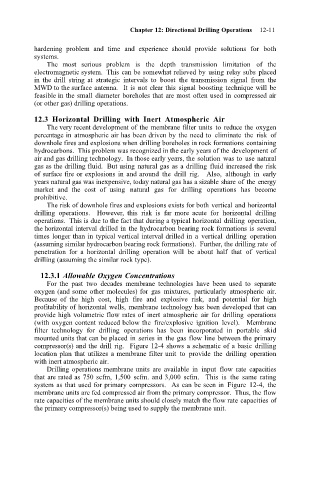Page 647 - Air and Gas Drilling Manual
P. 647
Chapter 12: Directional Drilling Operations 12-11
hardening problem and time and experience should provide solutions for both
systems.
The most serious problem is the depth transmission limitation of the
electromagnetic system. This can be somewhat relieved by using relay subs placed
in the drill string at strategic intervals to boost the transmission signal from the
MWD to the surface antenna. It is not clear this signal boosting technique will be
feasible in the small diameter boreholes that are most often used in compressed air
(or other gas) drilling operations.
12.3 Horizontal Drilling with Inert Atmospheric Air
The very recent development of the membrane filter units to reduce the oxygen
percentage in atmospheric air has been driven by the need to eliminate the risk of
downhole fires and explosions when drilling boreholes in rock formations containing
hydrocarbons. This problem was recognized in the early years of the development of
air and gas drilling technology. In those early years, the solution was to use natural
gas as the drilling fluid. But using natural gas as a drilling fluid increased the risk
of surface fire or explosions in and around the drill rig. Also, although in early
years natural gas was inexpensive, today natural gas has a sizable share of the energy
market and the cost of using natural gas for drilling operations has become
prohibitive.
The risk of downhole fires and explosions exists for both vertical and horizontal
drilling operations. However, this risk is far more acute for horizontal drilling
operations. This is due to the fact that during a typical horizontal drilling operation,
the horizontal interval drilled in the hydrocarbon bearing rock formations is several
times longer than in typical vertical interval drilled in a vertical drilling operation
(assuming similar hydrocarbon bearing rock formations). Further, the drilling rate of
penetration for a horizontal drilling operation will be about half that of vertical
drilling (assuming the similar rock type).
12.3.1 Allowable Oxygen Concentrations
For the past two decades membrane technologies have been used to separate
oxygen (and some other molecules) for gas mixtures, particularly atmospheric air.
Because of the high cost, high fire and explosive risk, and potential for high
profitability of horizontal wells, membrane technology has been developed that can
provide high volumetric flow rates of inert atmospheric air for drilling operations
(with oxygen content reduced below the fire/explosive ignition level). Membrane
filter technology for drilling operations has been incorporated in portable skid
mounted units that can be placed in series in the gas flow line between the primary
compressor(s) and the drill rig. Figure 12-4 shows a schematic of a basic drilling
location plan that utilizes a membrane filter unit to provide the drilling operation
with inert atmospheric air.
Drilling operations membrane units are available in input flow rate capacities
that are rated as 750 scfm, 1,500 scfm. and 3,000 scfm. This is the same rating
system as that used for primary compressors. As can be seen in Figure 12-4, the
membrane units are fed compressed air from the primary compressor. Thus, the flow
rate capacities of the membrane units should closely match the flow rate capacities of
the primary compressor(s) being used to supply the membrane unit.

